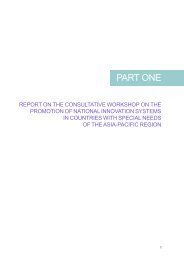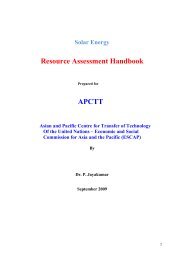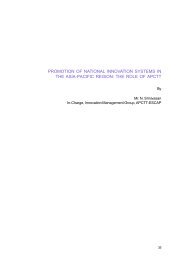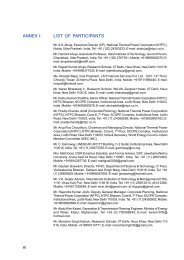Download Complete PDF - apctt
Download Complete PDF - apctt
Download Complete PDF - apctt
- No tags were found...
You also want an ePaper? Increase the reach of your titles
YUMPU automatically turns print PDFs into web optimized ePapers that Google loves.
Short supply of coal has started affecting thermal power plants. Coal India Limited(CIL) is currently unable to ramp up production capacity as required to maintain stocksin thermal plants. Around 25-30 power plants have critical stock of less than 7 daysevery month. This is expected to worsen in future if CIL is unable to ramp up significantly.CIL is only promising take or pay for 50 per cent of the capacity in its PPA to privateutilities. Imported coal requirements will increase in future to offset shortage of domesticcoal.The Ministry of Coal has awarded around 105 blocks with a cumulative capacity ofaround 28,000 million tonnes, which could ideally support the addition of 180,000 MW.More than 80 per cent of the captive block have been allotted only in the last five years.Coal mine developers confront a number of issues such as:• Land acquisition – Social issues pertaining to land acquisition, rehabilitation andresettlement have delayed several projects including those of the large centralpublic sector undertaking;• Environmental and forest clearances – With the implementation of “go-no go”classifications, coal mining projects have run into further delays;• Implementing projects – Many mining projects have faced inordinate delays due tolack of experience and expertise in coal mining. Many captive coal block ownershave preferred to appoint mine developers and operators on turnkey basis;• Financing – The world has changed since the financial downturn and the minershave to face cautious financiers even when they have cash surpluses to pick theequity components; and• Infrastructure development – Niners are faced with projects with no infrastructurebackbone to support productions and dispatches and the missing link betweenthe coal and their power plants.C. Challenges in financingThe macroeconomic environment is disappointing, with global economic recovery stillstalling and commodity prices being on the rise. In India, inflation continues to be high,forcing the Reserve Bank of India (RBI) to resort to aggressive monetary policy actions.CIL resorted to a rate hike (by almost 30 per cent) in February 2011 and has demandedanother round of revision in keeping with increasing input costs and pay revisions.Indian developers are thus faced with the double whammy of increasing commodityprices and cost of borrowings.Banks and Infrastructure Finance Companies (IFCs) account for about 85 per cent ofthe total loans to the power sector with banks being the primary sources of funds forprivate borrowers (Figure 3-34). The total amount of loan outstanding against the powersector is estimated at Rs 6,500 billion (US$127.78 billion), with banks accounting forapproximately 46.1 per cent, IFCs about 38.5 per cent, and government lending throughgrants and other financial institutions – such as the Life Insurance Corporation of India(LIC) and Employees’ Provident Fund Organization (EPFO) – bearing the remaining15.4 per cent. State Electricity Boards account for 46.1 per cent of loan outstanding.Sector/environment concerns have made financiers proceed with caution: some largedevelopers have multiple projects under construction and the leverage has increased.Financiers are wary of lending further without enhancement in equity base. Power126







